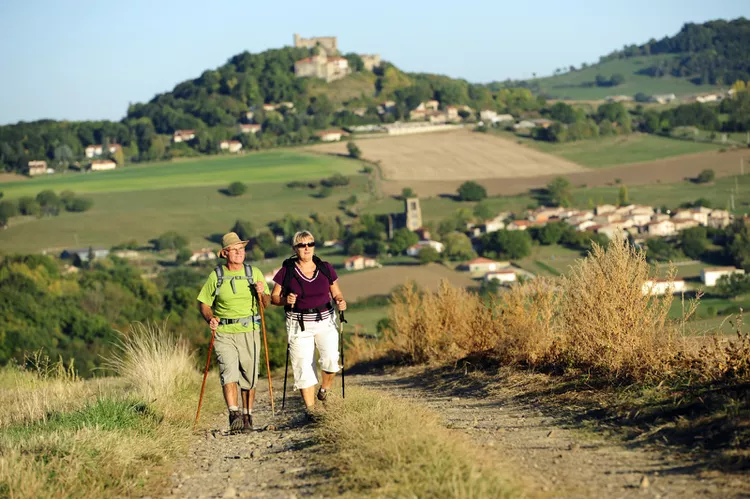France is a remarkable country to walk in, offering diverse regions and various types of walking routes. By planning in advance, you can ensure a very enjoyable vacation.
First Things First: Plan Your Route
Start by deciding which part of France you want to explore. Once you’ve chosen a region, look into the main walking routes available. For longer paths, selecting a smaller section is advisable to begin with. If you enjoy your experience in the region, you can always return to continue the adventure on another trip.
Particularly, the Pilgrim Routes in France are frequented by individuals who return annually to complete the entire passage to Santiago de Compostela in northwest Spain, a significant pilgrimage destination in Europe.
- Main Pilgrim Routes from France to Spain: There are five primary trails originating from various parts of France, showcasing stunning scenery.
Useful Websites
The following websites provide valuable information on walking in France:
- Fédération Francaise de la Randonnée (French Federation of Walking Paths) is devoted to long-distance footpaths. Although much of the information is in French, they offer comprehensive guides worth acquiring, as well as e-guides on their website.
- About-France.com provides useful information in English.
- GR – Long Distance Footpaths features maps, descriptions, and lodging suggestions in English.
- Traildino claims to be the world’s largest hiking database, containing detailed descriptions of multiple walking routes.
Maps
A specialized map available at a scale of 1:100000, titled France, sentiers de grande randonnée, is published by the Institut Géographique National (IGN). You can acquire this map from most well-stocked travel bookshops or directly from FFRP.
Yellow Michelin maps at a scale of 1:200000 highlight the most significant long-distance paths. However, for walking purposes, maps at scales of 1:50000 or 1:25000 are recommended. All 1:25,000 maps include coordinates necessary for GPS positioning.
Moreover, all tourist offices offer high-quality maps and books detailing local routes; be sure to obtain them before beginning your journey.
Official Paths
Sentiers de Grande Randonnée are long-distance walking paths, referred to as “GR” followed by a number (e.g., GR65). These extensive trails often connect to paths across Europe and are denoted by markings on trees, posts, and rocks with a short red band above a white band. Approximately 40,000 miles of these exist in France.
Chemins de Petite Randonnée are shorter local paths denoted as “PR” followed by a number (e.g., PR6). These may connect to GR paths and typically run from village to village or to historical sites. PR routes are marked with a yellow band above a white band.
Grandes Randonnées du Pays (GRP) routes form circular paths. GRP routes are represented by two parallel flashes, one yellow and one red.
Accommodation
Along the routes, you will find varying types of accommodations, ranging from basic to luxurious options. Typically, travelers stay somewhere in the mid-range of this spectrum. Choices include bed and breakfasts (chambres d’hôtes), walker’s hostels (gites d’étape), and hotels. Refuges, primarily located in national parks and mountainous regions, will be signposted.
It is advisable to secure your accommodation in advance, particularly during the summer months, to avoid arriving in remote towns without available lodging.
- Bed and breakfasts (chambres d’hôtes) offer a range of prices and are excellent for mingling with fellow travelers. Some owners and guests may speak English, though communication may prove challenging without knowledge of French.
- You can find gites d’étape and refuges that provide comfortable accommodation.
- For hotels, consider checking Logis de France.
Local tourist boards can be very supportive and assist with advance email bookings.
General Tips
Weather
- Always check the weather before starting your day. Meteo France provides thorough forecasts.
- Summers can be quite hot, so carrying suitable clothing is essential; a good hat and sunscreen are highly recommended. France offers a variety of sports gear, so should you need supplies, large supermarkets like Decathlon or local specialized shops usually have what you need.
- As weather can shift unexpectedly depending on your walking location, be prepared for climate changes and sudden heavy rain. Thus, take a waterproof hat and reliable rain shell, as well as warm clothing in case of cold and wet conditions.
What to Take
- Your packing list should vary based on whether you are walking solo, in remote areas, or with a guided group. Regardless, it’s wise to prepare for potential separation from your group.
- Essentials include a compass, GPS, a mobile phone, and a whistle for attracting attention.
- Pack quick energy-reviving snacks such as energy bars and chocolate, and make sure to carry sufficient water.
- Additionally, have spare socks and necessary items like a blister kit, adhesive bandages, and insect repellent.
Enjoy your walks!





